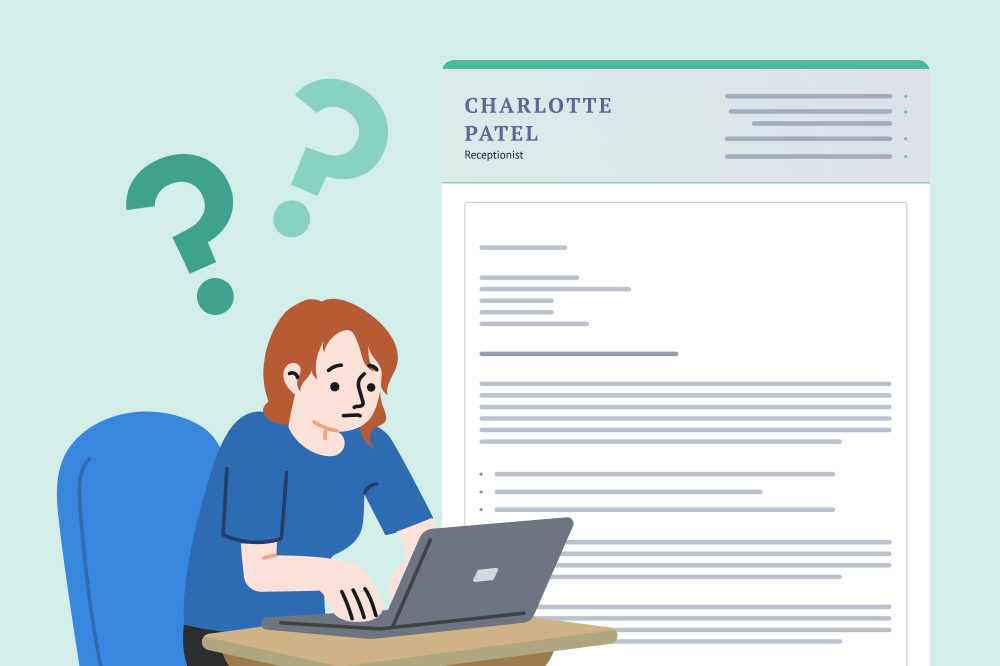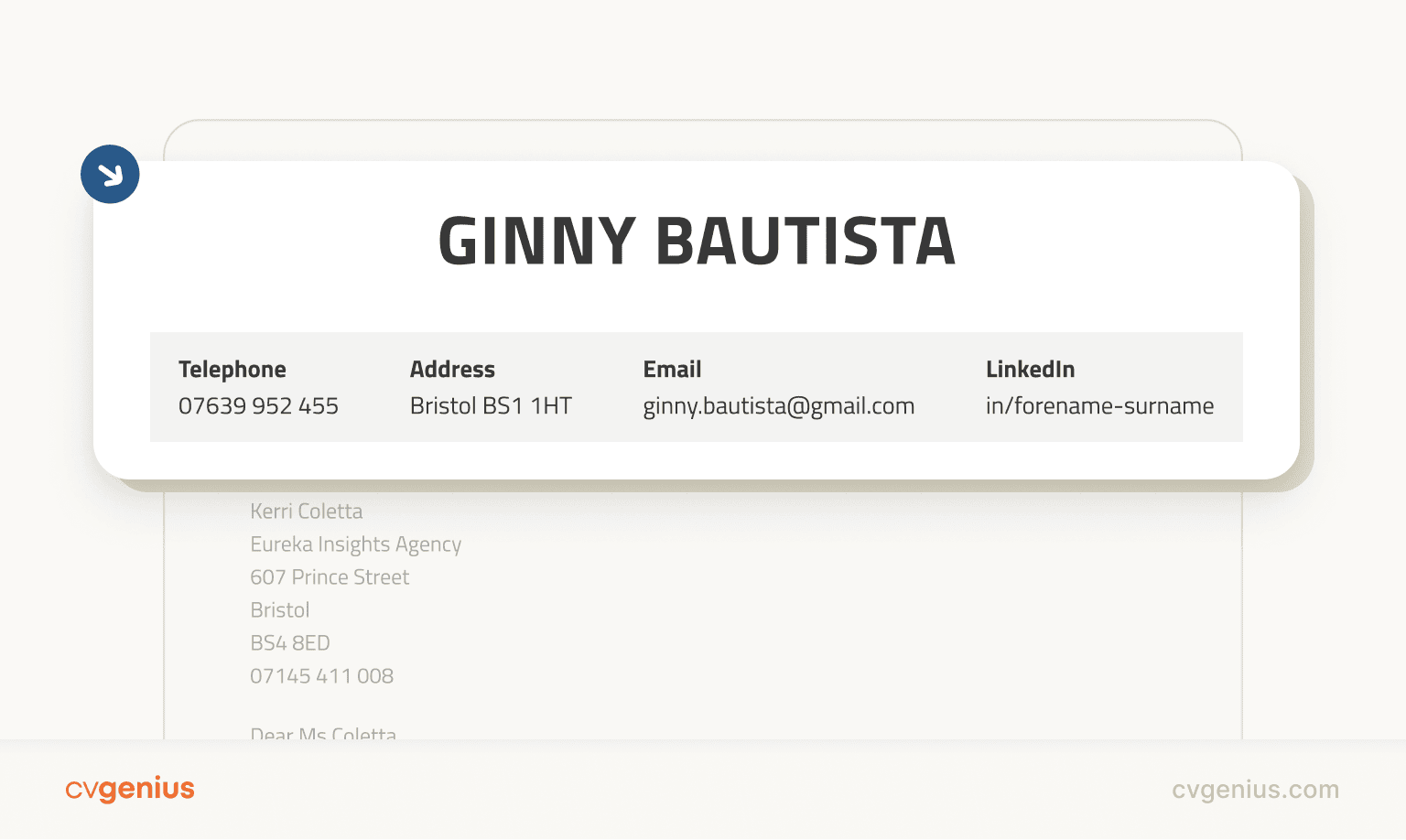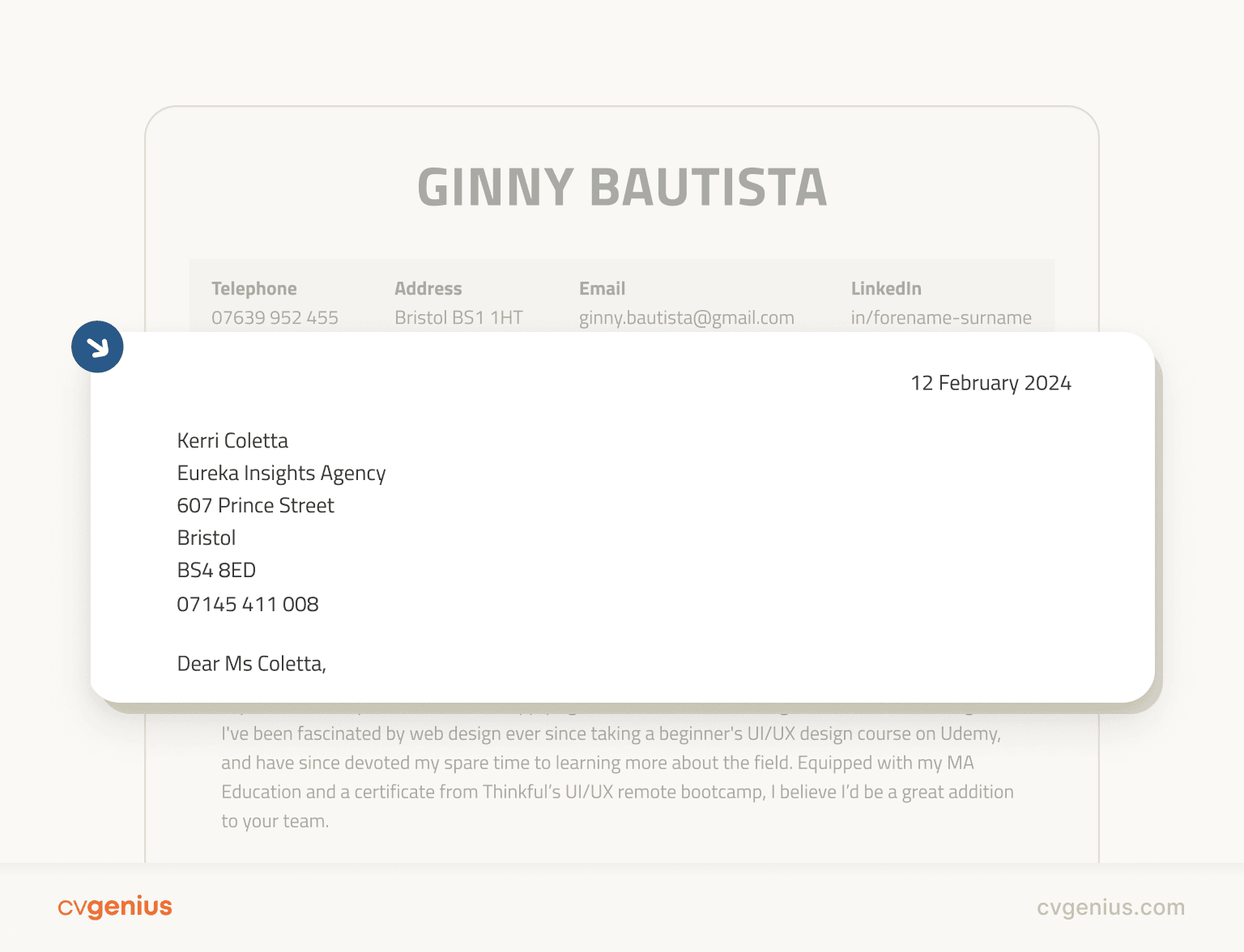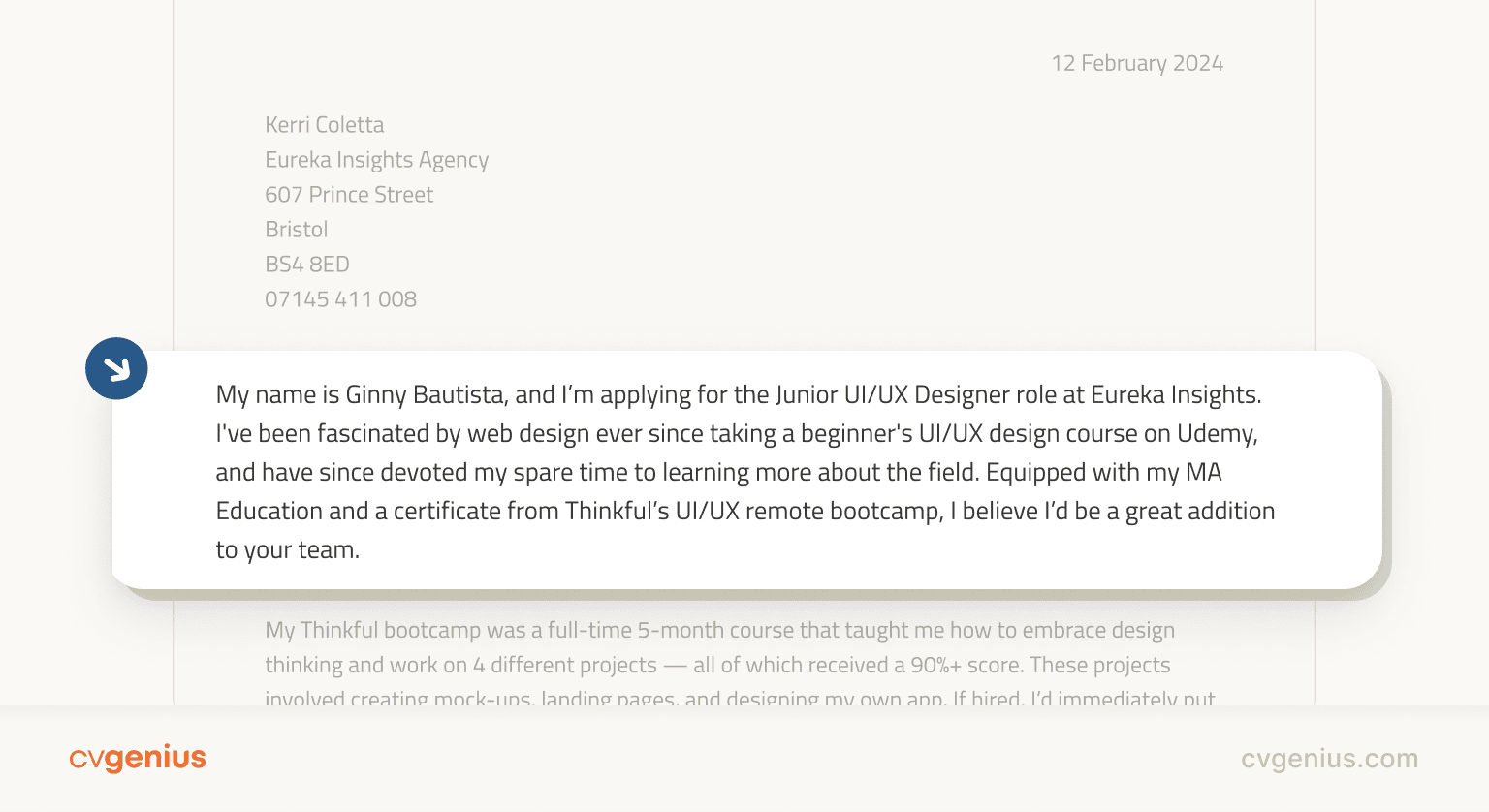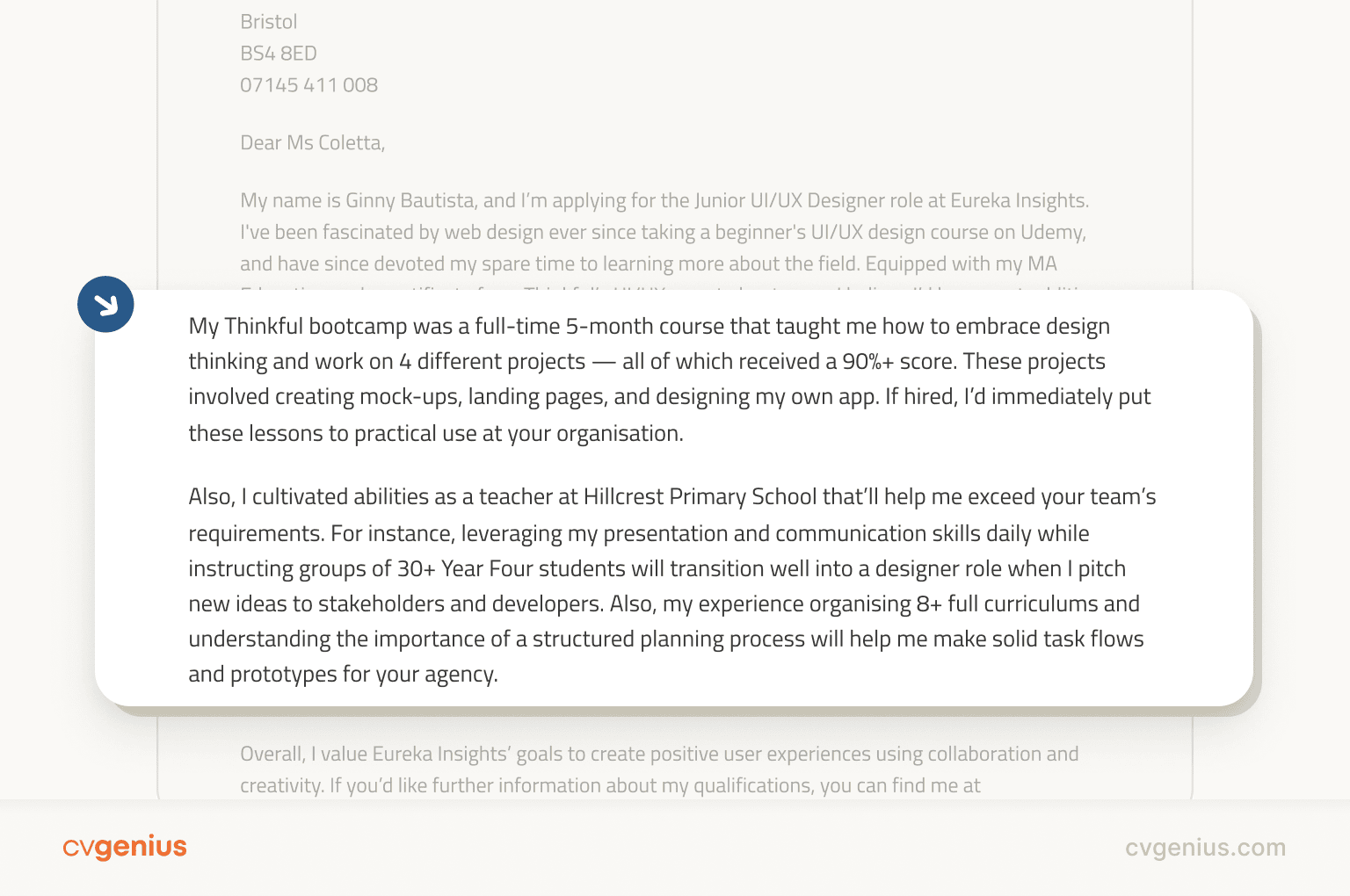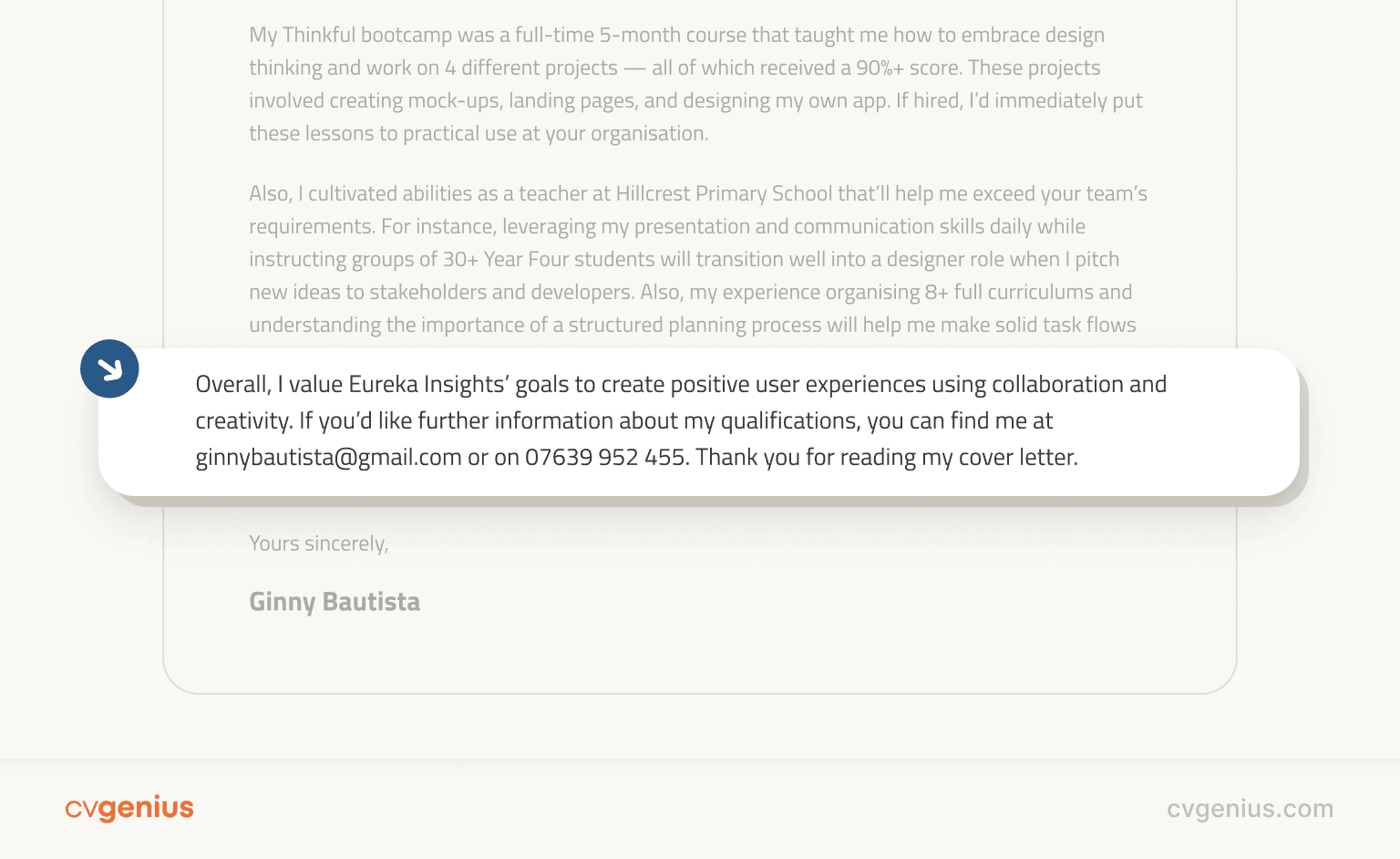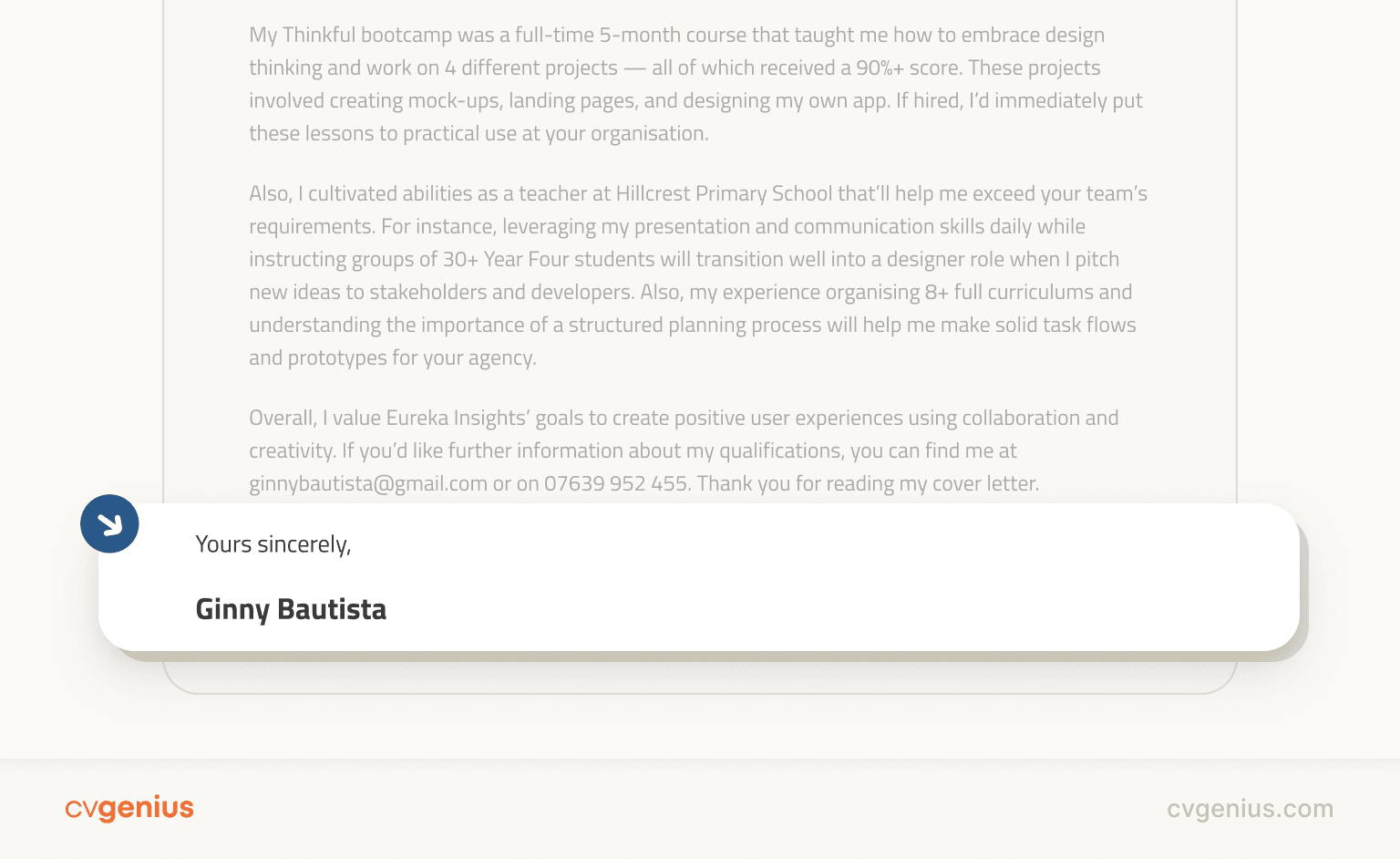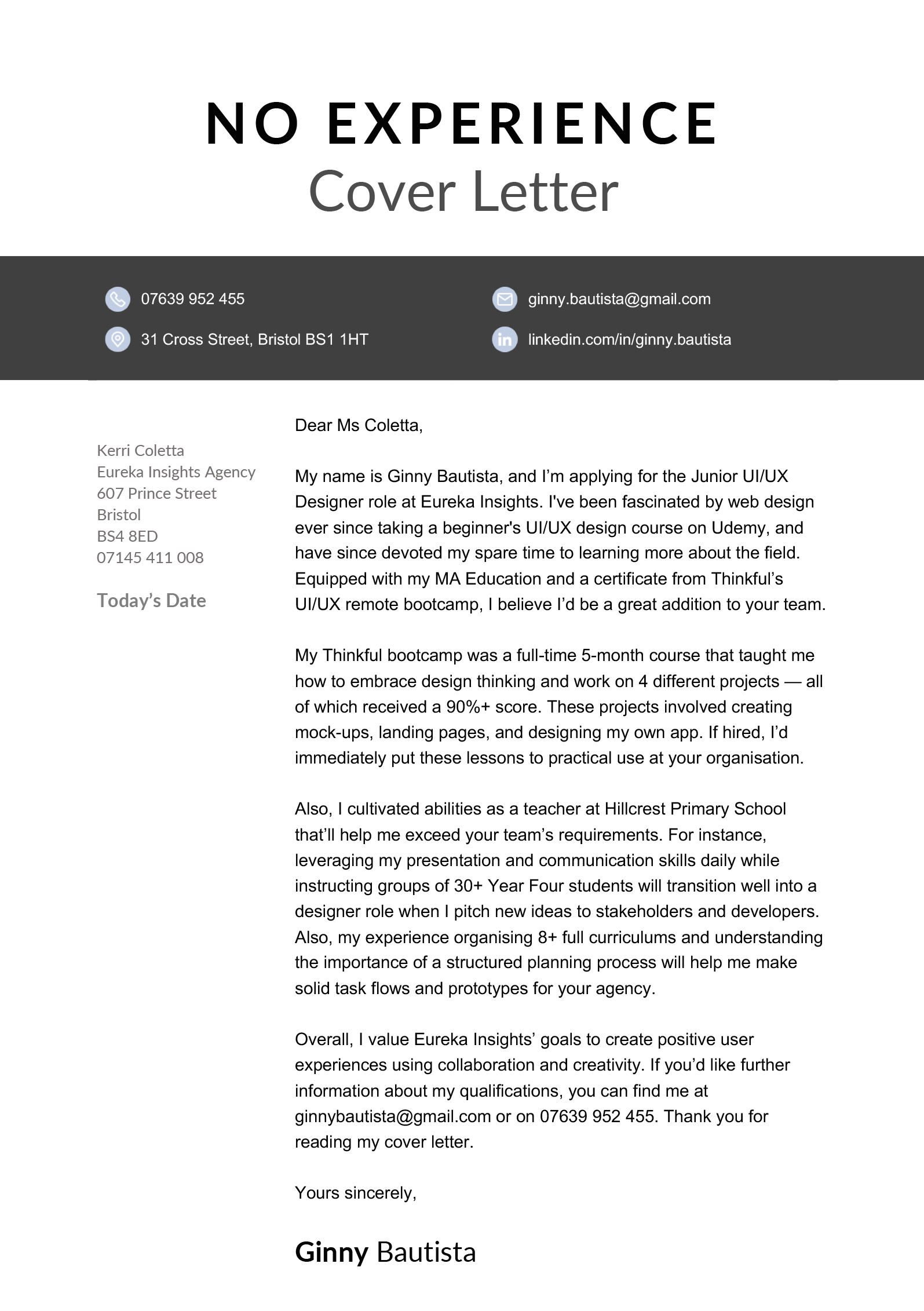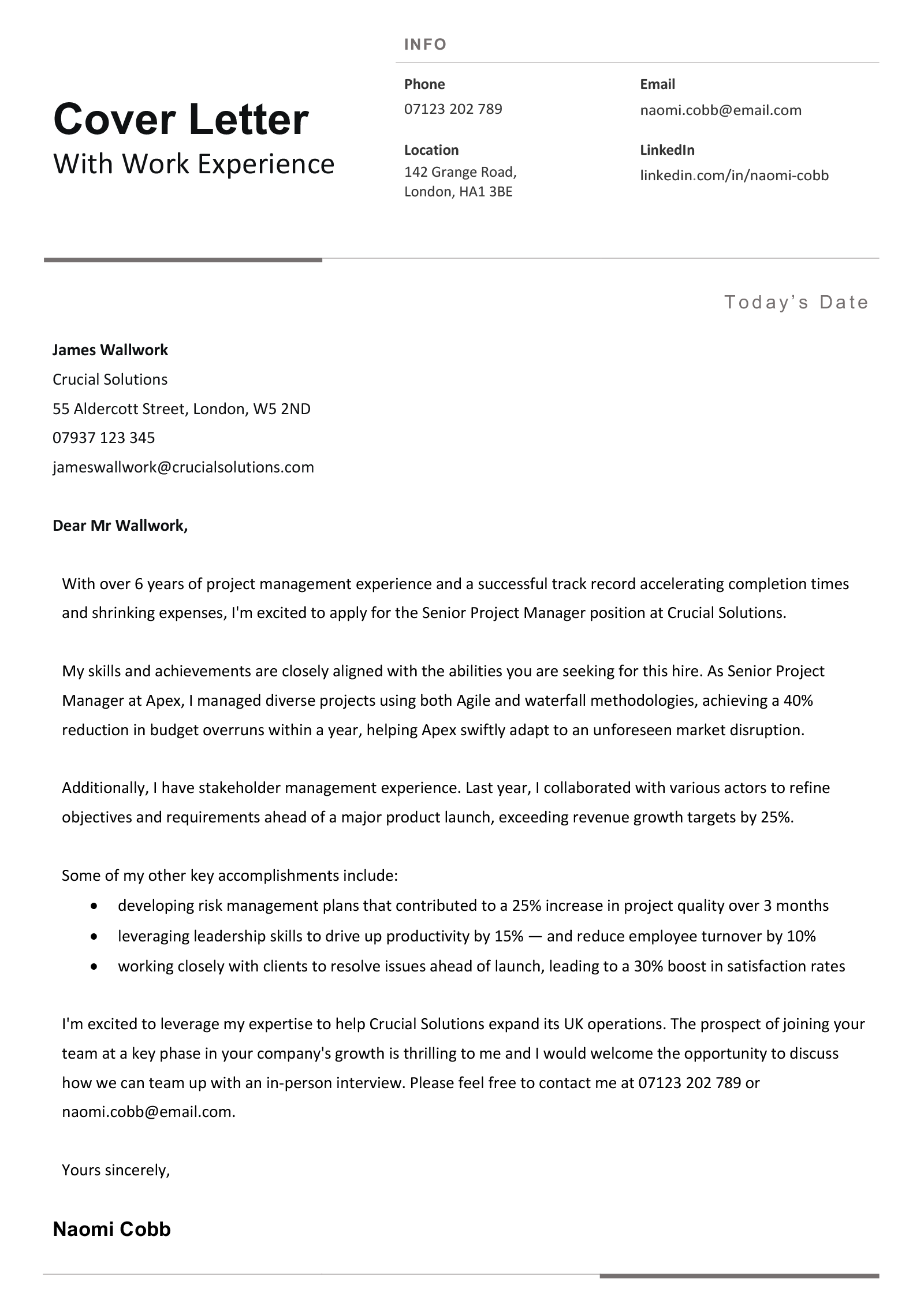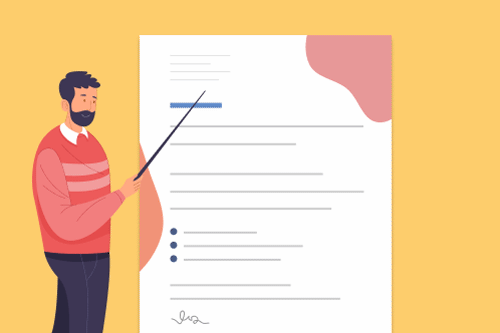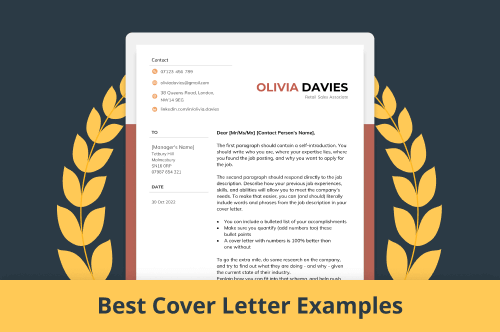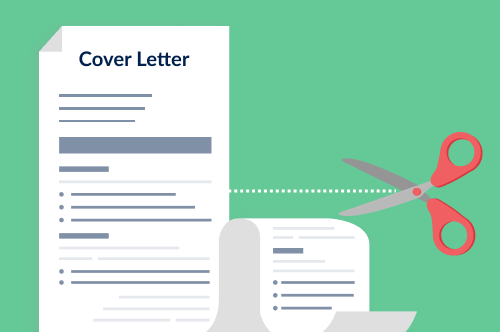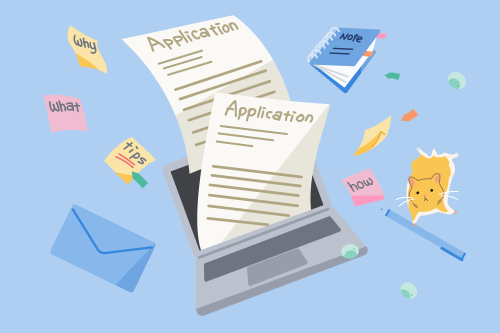New to job hunting? Watch our video on writing a cover letter with no experience:
Still wondering what a cover letter is? A cover letter is a formal, one-page letter highlighting why you want the job you’re applying for and what makes you qualified. Because you write your cover letter in your own words, it’s your chance to add some personality to your application and demonstrate why you’d be a great addition to the team.
Below we guide you through each step of writing a cover letter that makes employers want to interview you for the job opening. But first, you need to gather all the information you need to include in your cover letter:
What to include in a cover letter
Here’s a copy-and-paste cover letter template that shows you everything you need to include in your cover letter:
Keep scrolling to get more information on what to include in each section of your cover letter. Or if you just need to see more examples, you can skip down to our cover letter examples for different experience levels.
How to write a cover letter for a job
Writing the perfect cover letter is all about effective self-marketing. You identify the employer’s needs, values, and company culture, and then relate how your skills and experience make you a good fit.
If you don’t like writing, use a cover letter builder that does the writing for you in minutes based on your answers to a few simple questions.
Here’s how to write a job application letter that’ll impress even the pickiest HR manager in seven steps:
- Research the employer
- List your name and contact details
- Address the employer by name
- Write a targeted opening paragraph
- Explain why you’re qualified for the job
- Recap with a confident final paragraph
- Use a formal closing and sign your name
1. Research the employer
Before you start writing your cover letter, it’s important to research the employer so you better understand who you’re sending it to and what they look for in the ideal job applicant.
Start your research by carefully reading the job description.
You should get a good idea of the job’s responsibilities and required skills from when you write your CV. So if you’ve already finished your CV, read the job advert again, this time looking at how the employer talks about the job and company culture.
Is their description casual or serious? Sober or enthusiastic? Developing a profile of the employer will help you determine which of your personal qualities will be the best fit for their organisation.
In addition to the job description, check these resources to deepen your understanding of the employer:
- The ‘About Us’ page on their official website
- Their social media handles
- Company review sites like Glassdoor
Thoroughly researching the employer before you apply will enable you to align your cover letter more closely to their needs and preferences — which will make you more attractive to employers.
2. List your name and contact details
The top of your cover letter is where the reader will look first. Place your contact details in this area using an eye-catching cover letter header so they easily remember your name.
List the following contact details at the top of your cover letter:
- Name: first and last name (middle name optional)
- Phone number: mobile is best (never use your work number so your current employer doesn’t find out you’re thinking of leaving)
- Email address: pick one with your name because it’s professional and makes your application easier for employers to find in their inboxes
You can also add links to relevant web pages, such as your LinkedIn profile, online portfolio, or blog.
Adding your postal address to your cover letter is optional in 2024 because the employer will contact you by email or phone. And you definitely don’t need to add it to an email cover letter, as the employer will reach you by replying to your email.
However, if you want to highlight the fact that you live near the employer, go ahead and list your postal address on your cover letter.
3. Address the employer by name
Underneath your name and contact information, right-align the date and then switch to left alignment for your contact person’s information, including their:
- name (if you have it)
- company name
- company address
- company phone number
Then, you formally start your cover letter by addressing the employer by name, like so:
If you can’t find a contact person’s name in the job advert, you may need to do a little research. In this situation, you should:
- check the company’s website or LinkedIn to see who’s the department head for the role
- ring the company and ask who you should address your specific job application to
If all else fails, you can address your cover letter using a position title or department name:
Unable to find a common cover letter greeting that works for your application? Use ‘To Whom It May Concern,’. It’s not perfect, but it does the job.
4. Write a targeted opening paragraph
Make sure employers read your entire cover letter by speaking to their interests right from the start.
You can get the employer’s interest by starting your cover letter with a concise yet targeted first paragraph that includes the following information:
- Who you are: your professional background
- The job title: the name of the company and the position you want
- How you discovered the opening: where you saw the job advert (employers appreciate having this information so they can track their success on different hiring platforms)
- Your interest in the position: your enthusiasm for the role and what drove you to apply (especially if you’re writing a career change cover letter)
- Your notable accomplishments: one or two of your most important achievements to show that you’re qualified
Here’s an example of an opening paragraph that includes all the important details:
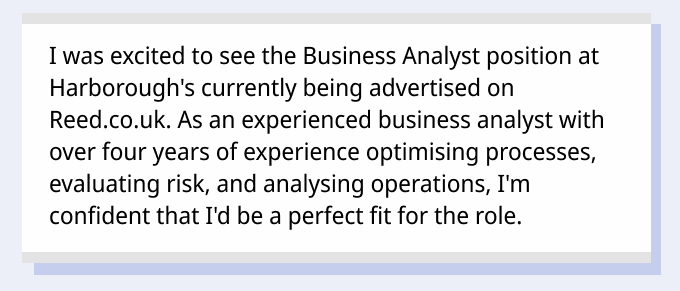
If you were referred to the job by someone working there, clearly state that referral in your cover letter introduction. Mentioning a referral can significantly increase your chances of landing an interview.
5. Explain why you’re qualified for the job
Your second and third paragraphs should explain why you’re a good fit for the job by highlighting your relevant experience, skills, and qualifications.
Consider adding a short bulleted list to your cover letter body if you have several skills or accomplishments that you want to highlight. Bullets also break up text and make your cover letter easier to read.
Here are some details you can discuss in your body paragraphs to show that you’re a great fit for the job:
- Achievements: Exceeded your sales goals at work or finished a major project at university? Highlight accomplishments like those in your cover letter.
- Awards: Mention any awards you received at school, university, or work.
- Praise: Have your employers praised you for your work? Use your cover letter to showcase moments your contributions were applauded.
Any accomplishments on your cover letter should be directly relevant to the job you want or demonstrate transferable skills that would be useful for the position.
Here’s an example of how to effectively demonstrate your achievements and relate them back to the job requirements in the body of your cover letter:
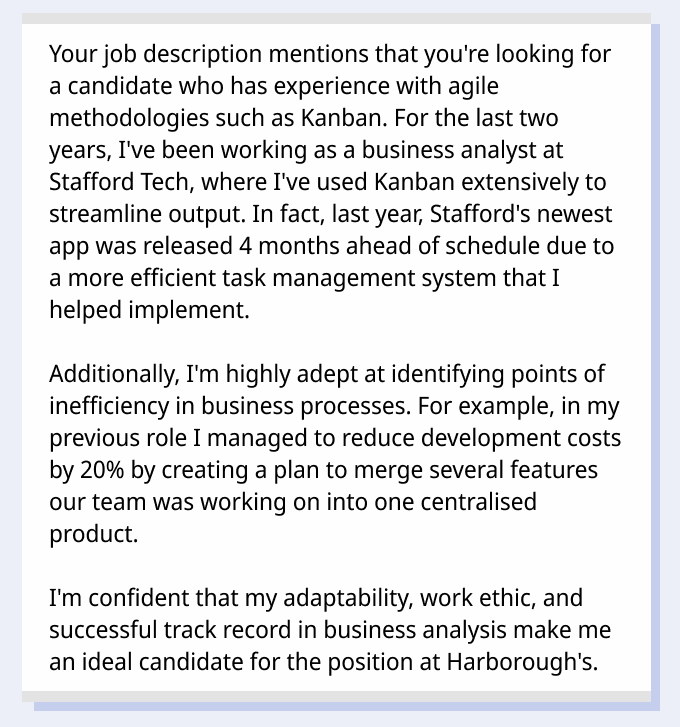
Note how the applicant who wrote this example uses hard numbers to make your achievements stand out to the employer. You should also use data to achieve the same effect when you write your cover letter. For example, you could specify how much money you saved a client or how many new employees you trained.
6. Recap with a confident final paragraph
To write a good closing for your cover letter, all you need to do is thank the employer for reading your letter and politely request an interview.
Additionally, you can repeat your phone number and email address to make it easier for the interviewer to get in touch.
Here’s what the correctly formatted final paragraph of a cover letter should look like:
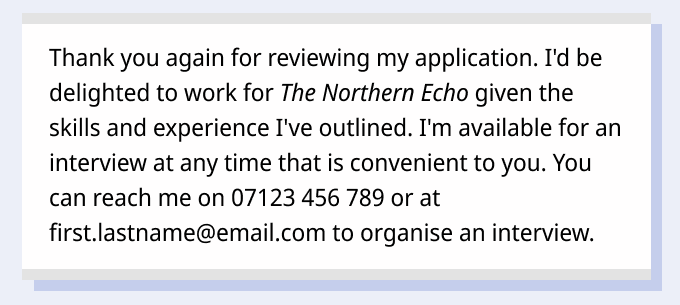
Make sure the phone number and email address you provide at the bottom of your cover letter match the ones you put in your header and CV. Otherwise, you risk confusing the recruiter and causing them to move on to the next application.
7. Use a formal closing and sign your name
Finally, close your cover letter by writing a polite sign-off and writing your name.
The rules for cover letter sign-offs are simple:
- If you addressed the reader by name (for example, ‘Dear Ms Stephanopolous,’) then end with ‘Yours sincerely,’
- If you used a job title (‘Dear Sales Manager,’) or generic greeting (‘Dear Sir or Madam,’) then end with ‘Yours faithfully,’
This distinction might seem minor, but applying proper letter-writing etiquette when ending your cover letter shows the reader that you’re a professional.
Examples that show how to write a cover letter
Now that you know the basics of how to write a good cover letter, here are two examples that demonstrate how to put these lessons into practice. The first example was written by a person with no work experience, while the second was made by an experienced professional applying for a management position:
1. Example of how to write a cover letter with no experience
Don’t have any full-time work experience? You can still write a compelling cover letter by emphasising your job-related education and volunteer or internship experience.
This cover letter for an entry-level job highlights the applicant’s independent study experience to show how they’re prepared for the responsibilities of a professional role:
No-Experience Cover Letter Example (Text Version)
Ginny Bautista
31 Cross Street
Bristol
BS1 1HT
07639 952 455
ginny.bautista@gmail.com
linkedin.com/in/ginny.bautista
Today’s Date
Kerri Coletta
Eureka Insights Agency
607 Prince Street
Bristol
BS4 8ED
07145 411 008
Dear Ms Coletta,
My name is Gina Bautista, and I’m applying for the Junior UI/UX Designer role at Eureka Insights. I’ve been fascinated by web design ever since taking a beginner’s UI/UX design course on Udemy, and have since devoted my spare time to learning more about the field. Equipped with my MA Education and a certificate from Thinkful’s UI/UX remote bootcamp, I believe I’d be a great addition to your team.
My Thinkful bootcamp was a full-time 5-month course that taught me how to embrace design thinking and work on 4 different projects — all of which received a 90%+ score. These projects involved sketching out wireframes and mock-ups on Figma, creating landing pages, and designing my own app. If hired, I’d immediately put these lessons to practical use at your organisation.
Also, I cultivated abilities as a teacher at Hillcrest Primary School that’ll help me exceed your team’s requirements. For instance, leveraging my presentation and communication skills daily while instructing groups of 30+ Year Four students will transition well into a designer role when I pitch new ideas to stakeholders and developers. Also, my experience organising 8+ full curriculums and understanding the importance of a structured planning process will help me make solid task flows and prototypes for your agency.
Overall, I value Eureka Insights’ goals to create positive user experiences using collaboration and creativity. If you’d like further information about my qualifications, you can find me at ginnybautista@gmail.com or on 07639 952 455. Thank you for reading my cover letter.
Yours sincerely,
Ginny Bautista
1. Example of how to write a cover letter with work history
When you have experience relevant to the job you’re applying for, make that experience the star of your cover letter, like so:
Cover Letter Example with Work History (Text Version)
Naomi Cobb
142 Grange Road
London
HA1 3BE
07123 202 789
naomi.cobb@email.com
linkedin.com/in/naomi-cobb
Today’s Date
James Wallwork
Crucial Solutions
55 Aldercott Street
London
W5 2ND
07937 123 345
jameswallwork@crucialsolutions.com
Dear James Wallwork,
With over 6 years of project management experience and a successful track record accelerating project completion times and shrinking expenses, I’m excited to apply for the Senior Project Manager position at Crucial Solutions.
I’ve spent the past few years fostering an impressive portfolio of skills and achievements that are closely aligned with the abilities you are seeking with this hire.
For example, as Senior Project Manager at Apex, I managed diverse projects using both Agile and waterfall methodologies, achieving a 40% reduction in budget overruns within a year, helping Apex swiftly adapt to an unforeseen market disruption.
Additionally, I have proven expertise in stakeholder management. Last year, I collaborated closely with various actors to refine objectives and requirements ahead of a major product launch, leading to revenue growth that exceeded targets by 25%.
Some of my other key accomplishments that will be of interest to you include:
- developing risk management plans and identifying dependencies that contributed to a 25% increase in project quality over 3 months
- leveraging leadership and motivational skills to drive up productivity by 15% — and reduce employee turnover by 10%
- working closely with key clients to anticipate and resolve issues ahead of launch, leading to a 30% boost in satisfaction rates
I’m excited to apply my expertise in these areas to help Crucial Solutions expand its UK operations. The prospect of collaborating with your team at a key phase in your company’s growth is thrilling to me and I would welcome the opportunity to discuss how we can team up with an in-person interview.
Please feel free to contact me at 07123 202 789 or naomi.cobb@email.com to set something up at a time that suits you.
Yours sincerely,
Naomi Cobb
Job-specific example cover letters can be an excellent source of inspiration if you’re unsure what to put in a cover letter for your industry.
Tips for writing a good cover letter
Here are some expert cover letter tips to help you perfect your job application:
- Apply proper cover letter formatting: Pick an easy-to-read cover letter font (Arial or Georgia, for example), and set your margins between 1.27–2.5 cm to maintain a professional balance of white space and text.
- Use a professional template: To ensure your cover letter looks professional, use a pre-made cover letter template and replace the information on it with your own.
- Write a new cover letter for every job you target: Employers don’t appreciate receiving cover letters that are obviously writing to apply for multiple jobs. So retool your cover letter to show how your skills and experience match each job’s specific requirements.
- Keep it to one page or less: More than one page is too much to expect a busy employer to read. But one page gives you plenty of space to make a strong first impression on the reader.
- Proofread: One typo is enough to make a recruiter view you as unprofessional. So edit your cover letter, ask a friend to proofread it with fresh eyes, and then edit it again to make sure it’s perfect.
Frequently asked questions about cover letter writing
Below are expert answers to four of the most common questions asked about how to write a cover letter:
1. How do I write a simple cover letter?
Here’s how to write a simple cover letter:
- Write your name at the top (left, centre, or right alignments are all fine)
- Right align your contact information and today’s date
- Left align the contact person’s name, company name, and contact information
- Address the contact person by name in a salutation (e.g., ‘Dear Ms Jackson,’)
- Write 2–4 paragraphs explaining what job you want and why you’re qualified for it
- Sign off with ‘Yours sincerely,’ followed by your name
2. Should my cover letter match my CV?
Yes, your cover letter should match your CV. So make sure you use the same formatting and contact information as your cover letter when you write your CV. And if you’re using a cover letter template, find one that has a matching CV template.
Unsure how to write a professional CV? Learning how to write an effective curriculum vitae will help you boost your application. Or you can use a good CV maker that uses AI to write and format your CV for you.
3. What is a cover letter for university?
A cover letter for university is also known as a personal statement.
Though professional cover letters and university personal statements are both formal self-introduction letters, they’re written differently because they have different purposes.
A cover letter for a job is a brief job application letter that outlines your main skills and experiences, explaining why you are the best candidate for a specific job.
Meanwhile, a university personal statement tells an admissions tutor why you want to enrol in a specific university course and why you’re a good fit for it.
4. How long does it take to write a cover letter?
How long it takes to write a cover letter depends on:
- how comfortable you are with writing
- if you have experience writing cover letters
- how much you want the position (you should devote more time to jobs you’re more interested in)
If the deadline to submit your cover letter is soon, you can write a cover letter in as little as 20 minutes, for example, if writing a short cover letter or using AI to write your cover letter.
But to maximise the number of cover letters you send out while making sure each one is well-written and customised, plan to spend roughly 1 hour per cover letter. One way to write a cover letter in 1 hour is to split your time evenly among researching the company, writing the first draft, and editing your cover letter.
